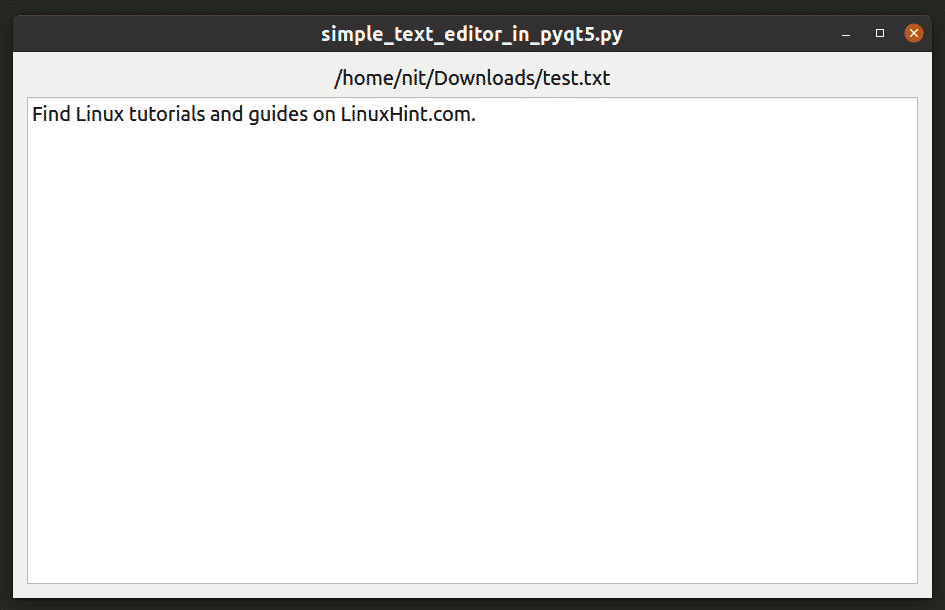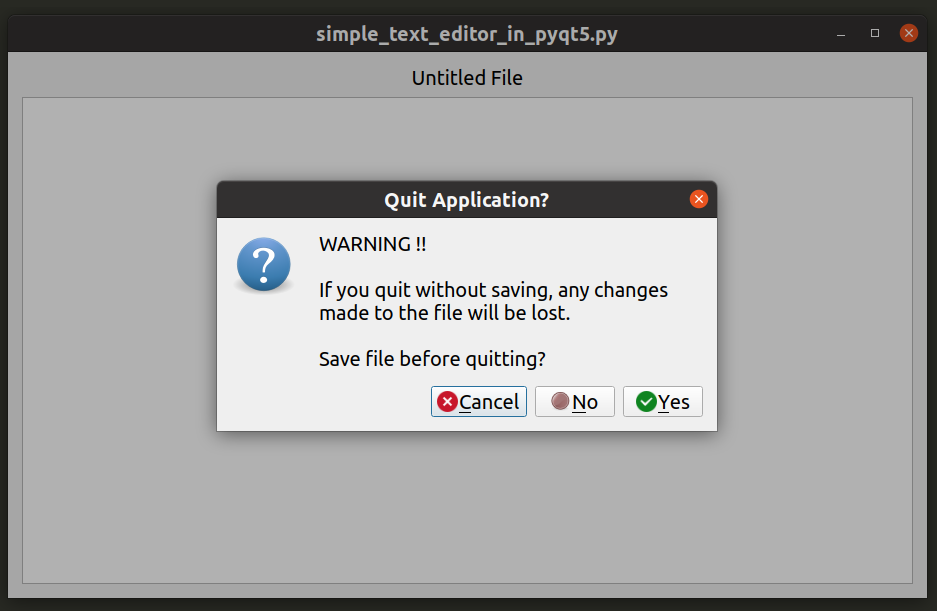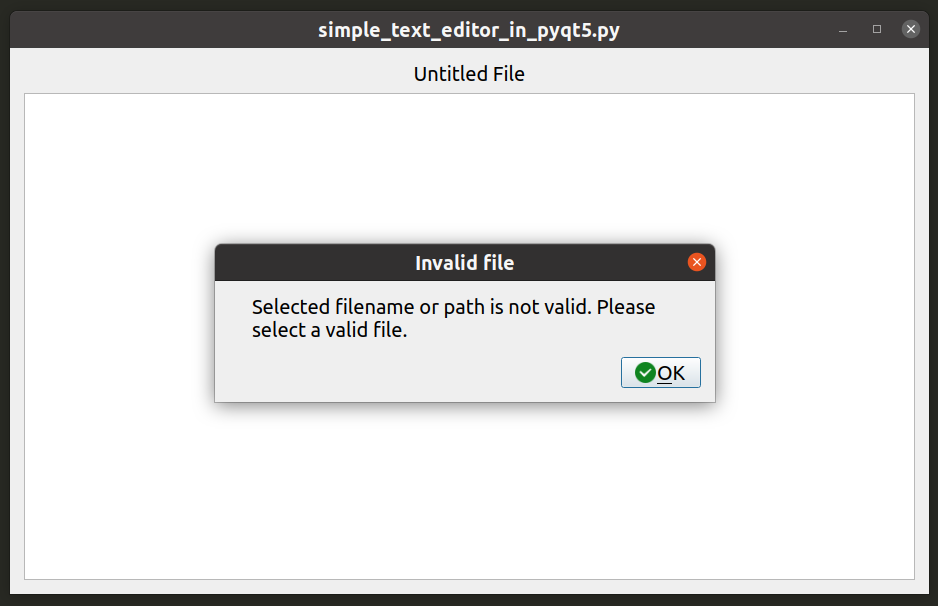How To Create Text That Gets Updated Pyqt5
This article will cover a guide on creating a simple text editor in Python3 and PyQt5. Qt5 is a prepare of cantankerous-platform libraries written in C++, used mainly for creating rich graphical applications. PyQt5 provides Python bindings for the latest version of Qt5. All lawmaking samples in this article are tested with Python three.8.2 and PyQt5 version 5.14.ane on Ubuntu twenty.04.
Installing PyQt5 in Linux
To install PyQt5 in latest version of Ubuntu, run the command below:
$ sudo apt install python3-pyqt5
If you are using any other Linux distribution, search for the term "Pyqt5" in the packet manager and install it from there. Alternatively, you can install PyQt5 from pip parcel manager using the command below:
Annotation that in some distributions, you may have to use pip3 command to correctly install PyQt5.
Total Code
I am posting full code beforehand then that you lot can better understand context for private lawmaking snippets explained after in the article. If you are familiar with Python and PyQt5, y'all can just refer to the lawmaking below and skip the explanation.
#!/usr/bin/env python3
import sys
from PyQt5.QtWidgets import QWidget, QApplication, QVBoxLayout, QHBoxLayout
from PyQt5.QtWidgets import QTextEdit, QLabel, QShortcut, QFileDialog, QMessageBox
from PyQt5.QtGui import QKeySequence
from PyQt5 import Qt
class Window(QWidget):
def __init__ ( self ):
super ( ).__init__ ( )
cocky.file_path = None
self.open_new_file_shortcut = QShortcut(QKeySequence( 'Ctrl+O' ) , self )
self.open_new_file_shortcut.activated.connect ( self.open_new_file )
self.save_current_file_shortcut = QShortcut(QKeySequence( 'Ctrl+S' ) , self )
self.save_current_file_shortcut.activated.connect ( cocky.save_current_file )
vbox = QVBoxLayout( )
text = "Untitled File"
self.title = QLabel(text)
self.title.setWordWrap ( True )
self.title.setAlignment (Qt.Qt.AlignCenter )
vbox.addWidget ( self.title )
cocky.setLayout (vbox)
cocky.scrollable_text_area = QTextEdit( )
vbox.addWidget ( self.scrollable_text_area )
def open_new_file( self ):
self.file_path , filter_type = QFileDialog.getOpenFileName ( self , "Open new file" ,
"" , "All files (*)" )
if self.file_path:
with open ( cocky.file_path , "r" ) as f:
file_contents = f.read ( )
self.title.setText ( self.file_path )
self.scrollable_text_area.setText (file_contents)
else:
cocky.invalid_path_alert_message ( )
def save_current_file( self ):
if non self.file_path:
new_file_path, filter_type = QFileDialog.getSaveFileName ( self , "Save this file
as..." , "" , "All files (*)" )
if new_file_path:
self.file_path = new_file_path
else:
self.invalid_path_alert_message ( )
return False
file_contents = cocky.scrollable_text_area.toPlainText ( )
with open ( self.file_path , "w" ) equally f:
f.write (file_contents)
self.championship.setText ( self.file_path )
def closeEvent( self , effect):
messageBox = QMessageBox( )
title = "Quit Application?"
message = "WARNING !!\due north \northIf you lot quit without saving, any changes made to the file
volition be lost.\due north \nSave file earlier quitting?"
answer = messageBox.question ( cocky , title, bulletin, messageBox.Yep | messageBox.No |
messageBox.Cancel , messageBox.Abolish )
if reply == messageBox.Yes:
return_value = cocky.save_current_file ( )
if return_value == Imitation:
event.ignore ( )
elif reply == messageBox.No:
event.take ( )
else:
event.ignore ( )
def invalid_path_alert_message( self ):
messageBox = QMessageBox( )
messageBox.setWindowTitle ( "Invalid file" )
messageBox.setText ( "Selected filename or path is non valid. Please select a
valid file." )
messageBox.exec ( )
if __name__ == '__main__':
app = QApplication( sys.argv )
w = Window( )
w.showMaximized ( )
sys.leave (app.exec_ ( ) )
Explanation
The first part of the lawmaking only imports modules that will be used throughout the sample:
import sys
from PyQt5.QtWidgets import QWidget, QApplication, QVBoxLayout, QHBoxLayout
from PyQt5.QtWidgets import QTextEdit, QLabel, QShortcut, QFileDialog, QMessageBox
from PyQt5.QtGui import QKeySequence
from PyQt5 import Qt
In the side by side office, a new class chosen "Window" is created that inherits from "QWidget" class. QWidget course provides ordinarily used graphical components in Qt. Past using "super" you can ensure that the parent Qt object is returned.
class Window(QWidget):
def __init__ ( self ):
super ( ).__init__ ( )
Some variables are defined in the next office. File path is set to "None" by default and shortcuts for opening a file using <CTRL+O> and saving a file using <CTRL+Southward> are defined using QShortcut class. These shortcuts are and then connected to their respective methods that are called whenever a user presses the defined fundamental combinations.
cocky.file_path = None
self.open_new_file_shortcut = QShortcut(QKeySequence( 'Ctrl+O' ) , self )
self.open_new_file_shortcut.activated.connect ( self.open_new_file )
self.save_current_file_shortcut = QShortcut(QKeySequence( 'Ctrl+S' ) , self )
cocky.save_current_file_shortcut.activated.connect ( cocky.save_current_file )
Using QVBoxLayout grade, a new layout is created to which child widgets will exist added. A center-aligned label is set for the default file name using QLabel class.
vbox = QVBoxLayout( )
text = "Untitled File"
cocky.championship = QLabel(text)
self.title.setWordWrap ( True )
self.title.setAlignment (Qt.Qt.AlignCenter )
vbox.addWidget ( self.title )
cocky.setLayout (vbox)
Side by side, a text area is added to the layout using a QTextEdit object. The QTextEdit widget will requite yous an editable, scrollable surface area to work with. This widget supports typical re-create, paste, cutting, disengage, redo, select-all etc. keyboard shortcuts. You lot can also use a correct click context card within the text surface area.
self.scrollable_text_area = QTextEdit( )
vbox.addWidget ( self.scrollable_text_area )

The "open_new_fie" method is called when a user completes <CTRL+O> keyboard shortcut. QFileDialog form presents a file picker dialog to the user. File path is determined after a user selects a file from the picker. If file path is valid, text content is read from the file and gear up to QTextEdit widget. This makes text visible to the user, changes the title to the new filename and completes the process of opening a new file. If for some reason, file path cannot be determined, an "invalid file" alert box is shown to the user.
def open_new_file( self ):
self.file_path , filter_type = QFileDialog.getOpenFileName ( self , "Open new file" , "" ,
"All files (*)" )
if cocky.file_path:
with open ( self.file_path , "r" ) as f:
file_contents = f.read ( )
self.championship.setText ( self.file_path )
self.scrollable_text_area.setText (file_contents)
else:
self.invalid_path_alert_message ( )

The "save_current_file" method is called whenever a user completes <CTRL+S> keyboard shortcut. Instead of retrieving a new file path, QFileDialog now asks the user to provide a path. If file path is valid, contents visible in QTextEdit widget are written to the full file path, otherwise an "invalid file" alert box is shown. Title of the file currently being edited is also changed to the new location provided by the user.
def save_current_file( self ):
if not cocky.file_path:
new_file_path, filter_type = QFileDialog.getSaveFileName ( self , "Salvage this file
equally..." , "" , "All files (*)" )
if new_file_path:
self.file_path = new_file_path
else:
cocky.invalid_path_alert_message ( )
return Fake
file_contents = self.scrollable_text_area.toPlainText ( )
with open ( self.file_path , "w" ) as f:
f.write (file_contents)
self.title.setText ( self.file_path )
The "closeEvent" method is part of the PyQt5 event handling API. This method is chosen whenever a user tries to close a window using the cross button or past hitting <ALT+F4> key combination. On firing of the close upshot, the user is shown a dialog box with three choices: "Yes", "No" and "Abolish". "Yeah" button saves the file and closes the application while "No" push button closes the file without saving the contents. "Cancel" push closes the dialog box and takes user back to the awarding.
def closeEvent( cocky , event):
messageBox = QMessageBox( )
title = "Quit Application?"
message = "Alert !!\n \due northIf you quit without saving, whatsoever changes made to the file volition
be lost.\due north \nSave file before quitting?"
respond = messageBox.question ( self , title, message, messageBox.Yes | messageBox.No |
messageBox.Cancel , messageBox.Cancel )
if reply == messageBox.Yes:
return_value = self.save_current_file ( )
if return_value == False:
event.ignore ( )
elif reply == messageBox.No:
event.accept ( )
else:
effect.ignore ( )

The "invalid file" warning box doesn't have any bells and whistles. It just conveys the message that file path couldn't be adamant.
def invalid_path_alert_message( cocky ):
messageBox = QMessageBox( )
messageBox.setWindowTitle ( "Invalid file" )
messageBox.setText ( "Selected filename or path is not valid. Please select a valid file." )
messageBox.exec ( )

Lastly, the chief awarding loop for consequence treatment and drawing of widgets is started by using the ".exec_()" method.
if __name__ == '__main__':
app = QApplication( sys.argv )
w = Window( )
due west.showMaximized ( )
sys.exit (app.exec_ ( ) )
Running the App
Just relieve full code to a text file, set the file extension to ".py", mark the file executable and run it to launch the app. For example, if the file name is "simple_text_editor.py", y'all need to run following ii commands:
$ chmod +x simple_text_editor.py
$ ./simple_text_editor.py
Things You can Do to Improve the Code
The code explained in a higher place works fine for a bare-bones text editor. However, it may not be useful for practical purposes as it lacks many features commonly seen in good text editors. You lot tin improve the code by adding new features similar line numbers, line highlighting, syntax highlighting, multiple tabs, session saving, toolbar, dropdown menus, buffer change detection etc.
Conclusion
This article mainly focuses on providing a starting ground for creating PyQt apps. If you find errors in the code or desire to suggest something, feedback is welcome.
Source: https://linuxhint.com/how-to-write-a-simple-text-editor-in-pyqt5/
Posted by: frasierpree1974.blogspot.com

0 Response to "How To Create Text That Gets Updated Pyqt5"
Post a Comment